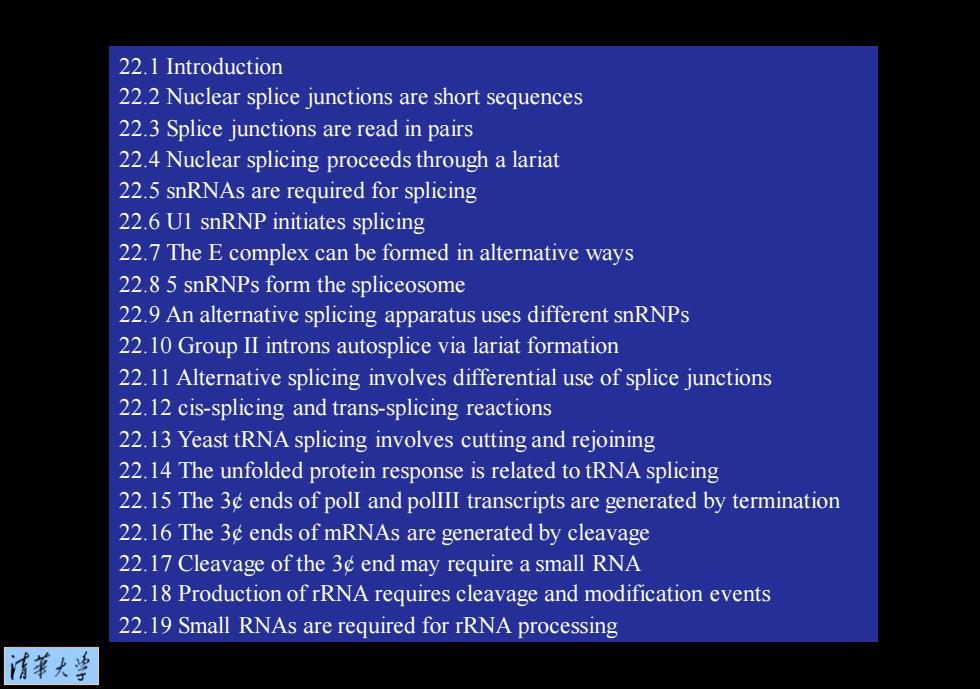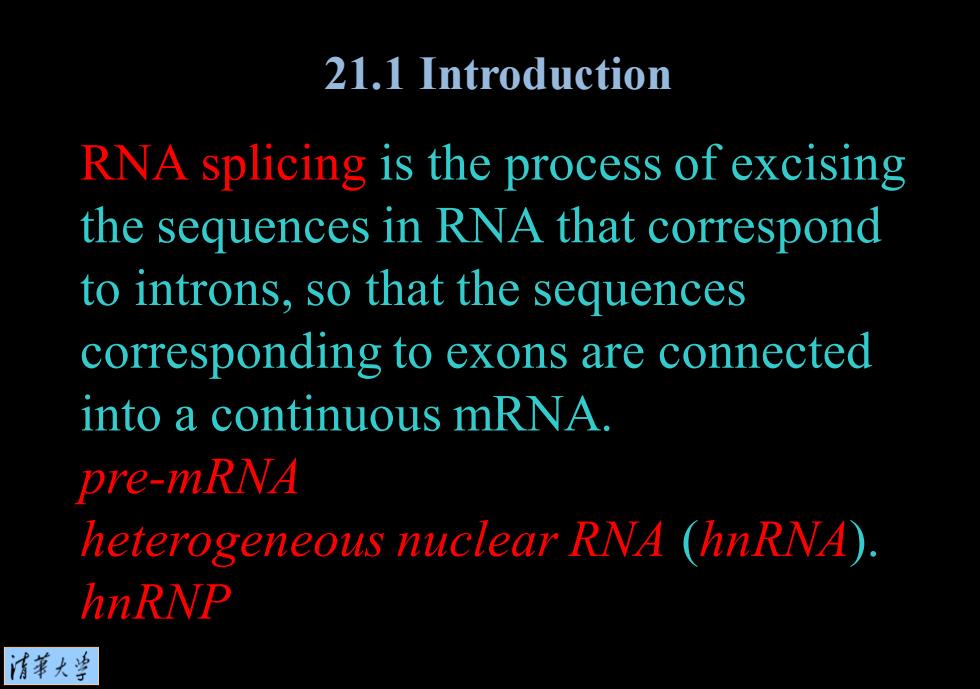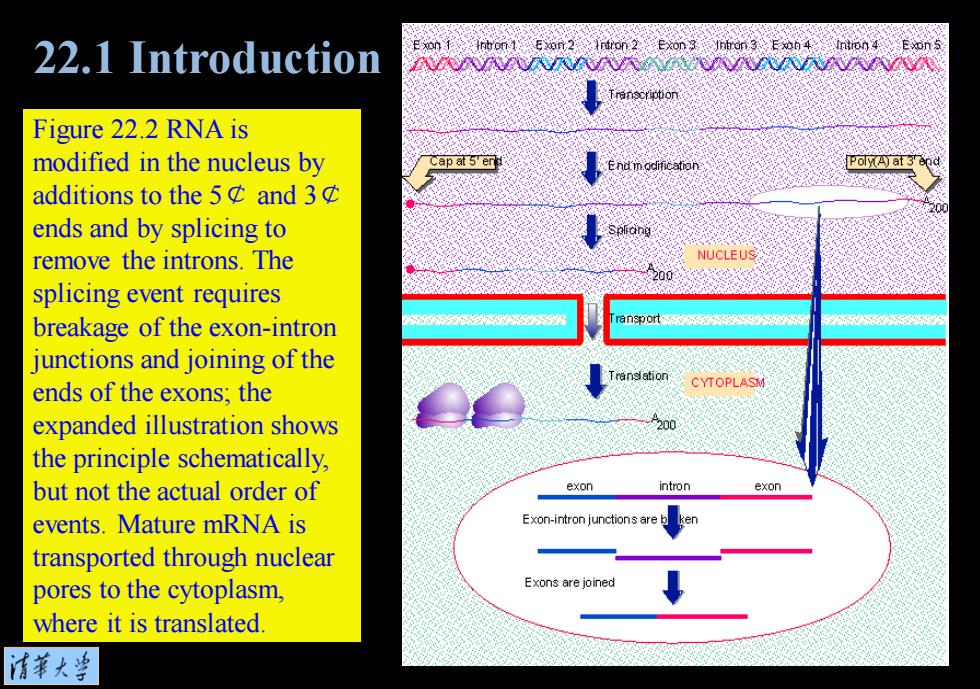
Chapter 22 Nuclear splicing 清革大当
Chapter 22 Nuclear splicing

22.1 Introduction 22.2 Nuclear splice junctions are short sequences 22.3 Splice junctions are read in pairs 22.4 Nuclear splicing proceeds through a lariat 22.5 snRNAs are required for splicing 22.6 Ul snRNP initiates splicing 22.7 The E complex can be formed in alternative ways 22.8 5 snRNPs form the spliceosome 22.9 An alternative splicing apparatus uses different snRNPs 22.10 Group II introns autosplice via lariat formation 22.11 Alternative splicing involves differential use of splice junctions 22.12 cis-splicing and trans-splicing reactions 22.13 Yeast tRNA splicing involves cutting and rejoining 22.14 The unfolded protein response is related to tRNA splicing 22.15 The 3 ends of poll and polllI transcripts are generated by termination 22.16 The 3c ends of mRNAs are generated by cleavage 22.17 Cleavage of the 3c end may require a small RNA 22.18 Production of rRNA requires cleavage and modification events 22.19 Small RNAs are required for rRNA processing 清菜大当
22.1 Introduction 22.2 Nuclear splice junctions are short sequences 22.3 Splice junctions are read in pairs 22.4 Nuclear splicing proceeds through a lariat 22.5 snRNAs are required for splicing 22.6 U1 snRNP initiates splicing 22.7 The E complex can be formed in alternative ways 22.8 5 snRNPs form the spliceosome 22.9 An alternative splicing apparatus uses different snRNPs 22.10 Group II introns autosplice via lariat formation 22.11 Alternative splicing involves differential use of splice junctions 22.12 cis-splicing and trans-splicing reactions 22.13 Yeast tRNA splicing involves cutting and rejoining 22.14 The unfolded protein response is related to tRNA splicing 22.15 The 3¢ ends of polI and polIII transcripts are generated by termination 22.16 The 3¢ ends of mRNAs are generated by cleavage 22.17 Cleavage of the 3¢ end may require a small RNA 22.18 Production of rRNA requires cleavage and modification events 22.19 Small RNAs are required for rRNA processing

21.1 Introduction RNA splicing is the process of excising the sequences in RNA that correspond to introns,so that the sequences corresponding to exons are connected into a continuous mRNA. pre-mRNA heterogeneous nuclear RNA (hnRNA). hnRNP 清苇大当
RNA splicing is the process of excising the sequences in RNA that correspond to introns, so that the sequences corresponding to exons are connected into a continuous mRNA. pre-mRNA heterogeneous nuclear RNA (hnRNA). hnRNP 21.1 Introduction

22.1 Introduction Figure 22.1 hnRNP hnRNA 200A 40S exists as a ribonucleopr otein particle 500-800 bases RNA_ organized as Core proteins (~30-40 kD) a series of beads. A1 A2 B1 B2 C1 C2 清菜大当
Figure 22.1 hnRNA exists as a ribonucleopr otein particle organized as a series of beads. 22.1 Introduction

22.1 Introduction 4o2 Figure 22.2 RNA is modified in the nucleus by Cap at 5 en PolyA at 3 end additions to the5¢and3¢ ends and by splicing to remove the introns.The NUCLEUS 200 splicing event requires breakage of the exon-intron junctions and joining of the ends of the exons;the Transation CYTOPLASM expanded illustration shows 200 the principle schematically, but not the actual order of exon intron exon events.Mature mRNA is Exon-intron junctions are b ken transported through nuclear pores to the cytoplasm, Exons are joined where it is translated. 清菜大兰
Figure 22.2 RNA is modified in the nucleus by additions to the 5¢ and 3¢ ends and by splicing to remove the introns. The splicing event requires breakage of the exon-intron junctions and joining of the ends of the exons; the expanded illustration shows the principle schematically, but not the actual order of events. Mature mRNA is transported through nuclear pores to the cytoplasm, where it is translated. 22.1 Introduction